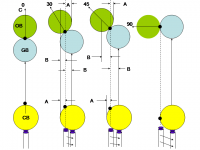A new thread to explain contact point on the OB to the contact point on the CB (CP2CP) aiming.
This assumes that one can visualize the contact point on the OB that when contacted by the CB there, it sends the OB to the pocket or target on the rail for banks.
- The contact point on the OB is the Black dot on the OB for the cut angle of interest.
- The contact point on the CB is the Black dot on the CB.
- The CB will appear to be larger than the OB so use the same proportion you visualize on the OB to the obverse side on the CB - A to A (from the edge) or B to B (from the center) as shown.
While standing with the cue outstretched.
- Line up the cue along a line that connects the two dots.
Then get down on the shot without moving the cue except to put your bridge under it.
- Shift the cue laterally and parallel until the tip of the cue is pointed at the center of the CB - for a center ball hit.
= When shifting the cue, move the bridge hand and the grip hand the same distance. Moving both hands together is best.
- Then shoot.

If shifting is difficult, then pivot the cue at its butt or your shoulder to start.
This assumes that one can visualize the contact point on the OB that when contacted by the CB there, it sends the OB to the pocket or target on the rail for banks.
- The contact point on the OB is the Black dot on the OB for the cut angle of interest.
- The contact point on the CB is the Black dot on the CB.
- The CB will appear to be larger than the OB so use the same proportion you visualize on the OB to the obverse side on the CB - A to A (from the edge) or B to B (from the center) as shown.
While standing with the cue outstretched.
- Line up the cue along a line that connects the two dots.
Then get down on the shot without moving the cue except to put your bridge under it.
- Shift the cue laterally and parallel until the tip of the cue is pointed at the center of the CB - for a center ball hit.
= When shifting the cue, move the bridge hand and the grip hand the same distance. Moving both hands together is best.
- Then shoot.

If shifting is difficult, then pivot the cue at its butt or your shoulder to start.